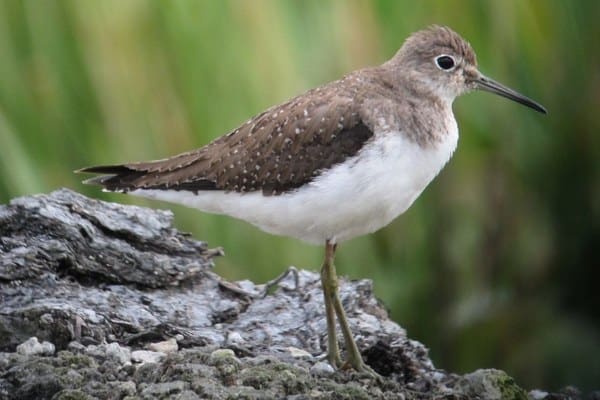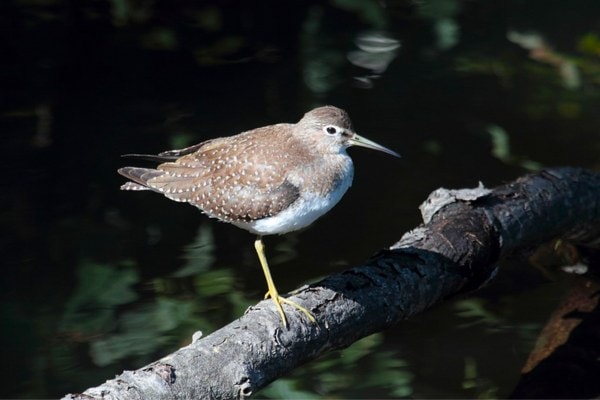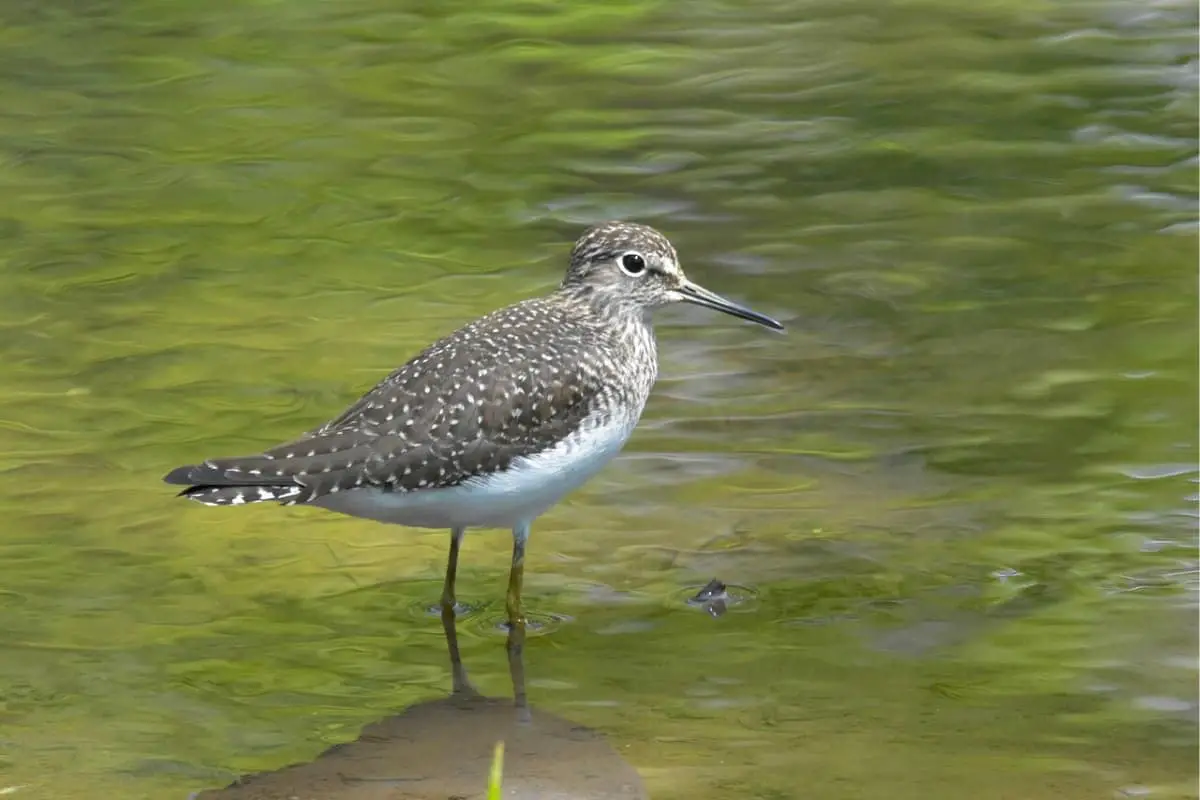Common Name: Solitary Sandpiper
Scientific Name: (Tringa solitaria)| Size | Diet | Range in Hawaii | Status in Hawaii |
|---|---|---|---|
| 7 in. - 9 in. | aquatic insects, small crustaceans, and aquatic invertebrates | Big Island, O'ahu, and Maui | Least Concern |
Meet the Solitary Sandpiper, also scientifically recognized as Tringa solitaria. This small shorebird species hails from North and South America, but it occasionally graces Hawaii’s shores as a non-breeding guest and wanderer. With its intriguing appearance and distinctive behaviors, the Solitary Sandpiper has become a source of fascination for bird enthusiasts worldwide.
In this article, let’s embark on a journey to discover the world of the Solitary Sandpiper, unravel its distinctive attributes, and uncover its occasional presence in the Hawaiian islands.
Solitary Sandpiper
Appearance

The Solitary Sandpiper is a small but distinctive shorebird, measuring approximately 7 to 9 inches in length. Its appearance is characterized by a striking white belly adorned with bold, dark spots, which stand out against its otherwise mottled brownish-gray plumage.
One of its most distinctive features is its bright yellow legs, adding a splash of vibrant color to its overall look. With a relatively short bill and a keen, observant gaze, the Solitary Sandpiper combines elegance and charm in its compact frame, making it a delightful sight for bird enthusiasts and nature lovers.
Diet
The Solitary Sandpiper boasts a diverse and dynamic menu that reflects its adaptability as a shorebird. Its diet is a delectable mix of aquatic and terrestrial treats. Wading along the water’s edge, it employs its keen bill to probe for aquatic insects, small crustaceans, and aquatic invertebrates with surgical precision.
During terrestrial forays, it snares land-based insects, spiders, and even earthworms with its swift strikes. This culinary flexibility allows the Solitary Sandpiper to thrive in various habitats, making it a master of both land and water and a testament to nature’s resourcefulness.
Nesting

The nesting habits of the Solitary Sandpiper reflect its name – solitary and unique. These shorebirds often choose solitary nesting sites in wooded or wetland areas, and unlike many other shorebirds, they don’t nest in colonies. Instead of building their own nests, they repurpose abandoned tree nests or select hidden spots in dense vegetation near water.
Their nests are simple depressions in the ground, lined with leaves, twigs, and other plant materials. What’s intriguing is their nesting behavior: while both the male and female take part in nest building, incubation duties, and chick-rearing, they often lead separate lives during the non-breeding season.
Behavior
These agile shorebirds are known for their elegant, solitary foraging style along the water’s edge. With a rhythmic bobbing motion and swift darting of their bill, they skillfully hunt for aquatic insects and small invertebrates.
But what truly sets them apart is their nomadic spirit. Solitary Sandpipers embark on impressive migrations, traveling from their breeding grounds in North America to their wintering destinations in South America. Their solitary nature during these long journeys contrasts with their social behavior during breeding, where they pair up for a brief period.
Intriguingly, these birds are also masters of mimicry. They sometimes imitate the alarm calls of other bird species to divert attention away from their nests, ensuring the safety of their eggs and chicks.
Habitat

This versatile shorebird can be found in a range of wetland environments across North and South America. From freshwater ponds and marshes to wooded swamps and riverbanks, the Solitary Sandpiper is equally at home in these diverse landscapes. Its knack for selecting concealed nesting sites in dense vegetation near water ensures its young remain protected from potential threats.
Range
The Solitary Sandpiper occasionally graces Hawaii’s shores as a non-breeding visitor and vagrant species. While they breed in Alaska, traverse Canada, and winter in Mexico and South America, these intrepid shorebirds have made sporadic appearances in the Hawaiian Islands. Notably, they’ve been spotted in the Southeastern Hawaiian Islands, including Hawai’i, O’ahu, and Maui, showcasing their remarkable wanderlust.
Conservation Status
The conservation status of the Solitary Sandpiper (Tringa solitaria) is a tale of relative stability, yet with a cautious eye on the future. This charismatic shorebird is categorized as a species of “Least Concern” by the International Union for Conservation of Nature (IUCN), indicating that it is not currently facing imminent global threats.
Interesting Facts
1. Vocal mimicry
Apart from mimicking other bird species to protect their nests, Solitary Sandpipers are also known for mimicking the calls of killdeer and other shorebirds during courtship displays.
2. Nocturnal travelers
During migration, Solitary Sandpipers are known to fly at night. They use the stars for navigation, making their nocturnal journeys even more remarkable.
3. Rapid growth
Solitary Sandpiper chicks grow quickly. Within a month, they can become proficient fliers, allowing them to disperse and explore their wetland habitats.
4. Ecological role
By foraging on aquatic insects and small invertebrates, Solitary Sandpipers help control pest populations in wetlands, contributing to the balance of these ecosystems.
5. Lunar synchronization
Some studies have suggested that Solitary Sandpipers may time their migratory departures to coincide with lunar phases. This synchronization might help them take advantage of favorable wind conditions for migration.
Frequently Asked Questions
1. Do Solitary Sandpipers have any cultural significance in indigenous communities or folklore?
Yes, Solitary Sandpipers may hold cultural significance in various indigenous communities in the Americas, where they may feature in traditional stories, art, and folklore, reflecting their importance in these cultures.
2. How long do Solitary Sandpipers live in the wild?
Solitary Sandpipers can live for several years, with some individuals known to reach ages of up to 10 years or more.
3. Are Solitary Sandpipers good swimmers?
While they are primarily shorebirds, Solitary Sandpipers are skilled swimmers and can navigate through shallow water while foraging.
4. How can I attract Solitary Sandpipers to my backyard or property?
Solitary Sandpipers are typically found in natural wetland habitats. Attracting them to a backyard is unlikely, as they prefer larger, more natural water bodies for foraging and nesting.
5. Are Solitary Sandpipers diurnal or nocturnal in their feeding habits?
Solitary Sandpipers are primarily diurnal (active during the day) when it comes to feeding and foraging along the water’s edge. However, they migrate at night to reduce predation risks.




